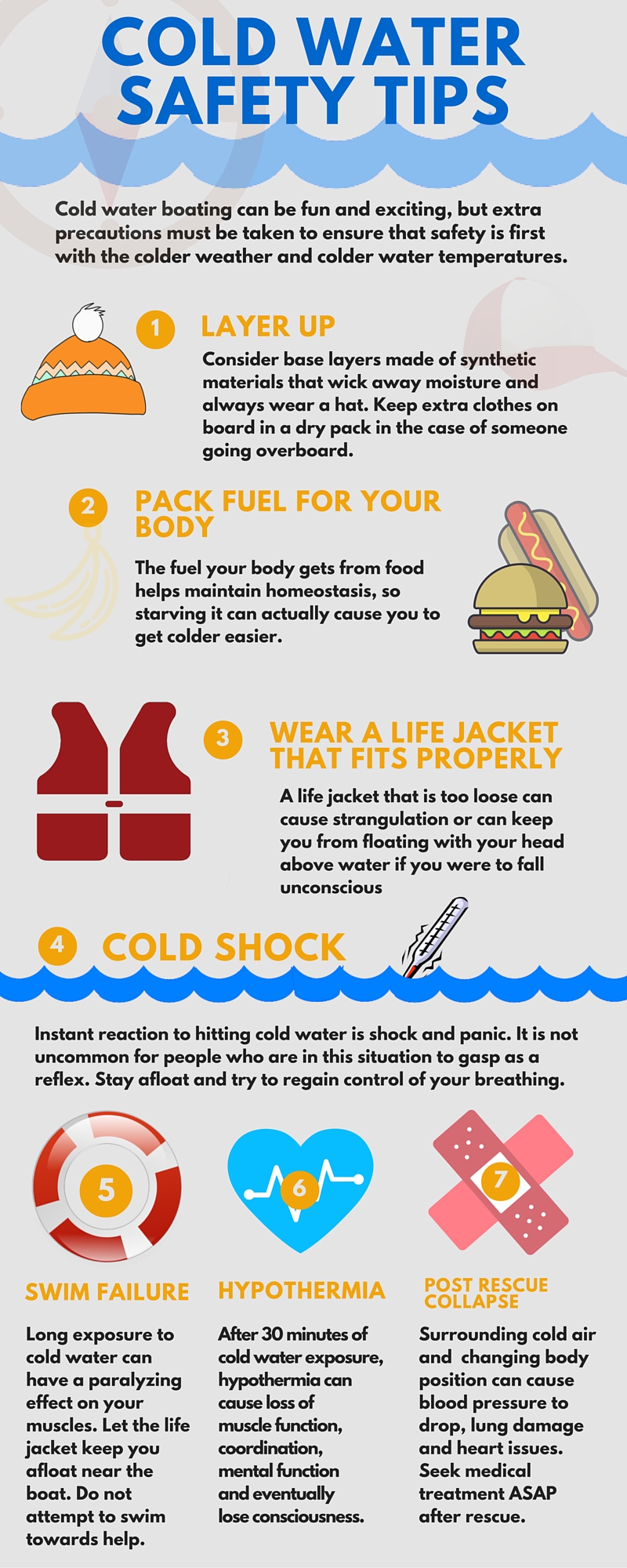
Boating season has ended but for some die-hard boating enthusiasts, the change of weather just means a change of approach in terms of boating. Cold water boating can be fun and exciting, but extra precautions must be taken to ensure that safety comes first with the colder weather and water temperatures.
If you are planning on boating in the colder weather, consider the following cold safety tips and preparations to stay warm and safe out on the water.
When going cold water boating, make sure that you are wearing multiple layers to protect your skin from cold air and water. As a general rule, dress according to the water’s temperature — not the air’s. Consider base layers made of synthetic materials that wick away moisture and always wear a hat. Keep extra clothes on board in a dry pack in the case of someone going overboard.
Avoiding hunger and keeping hydrated is crucial to staying alert, energized and maintaining your internal temperature. The fuel your body gets from food helps maintain homeostasis, so starving it can actually cause you to get colder easier. Pack snacks that are high in protein, bring plenty of water and keep a thermos of something warm to drink on hand.
No matter what type of boating you plan to do, wearing a properly fitted life jacket is critical to maintain your safety on the water. A life jacket that is too loose can cause strangulation or keep you from floating with your head above water if you were to fall unconscious. A comfortable life jacket can save your life and can double as an extra layer to keep you warm. Don’t forget to check your life jacket’s expiration date as well — materials and components do go bad over time.
If you or someone on board were to fall into the water, it is important to understand cold water safety and how the body reacts to being immersed in frigid water. Falling into cold water is incredibly dangerous and rescue needs to be swift. The following are the four stages of cold water immersion.
The instant reaction to hitting cold water is shock and panic. It is not uncommon for people who are in this situation to gasp as a reflex. If this happens underwater, choking or drowning could occur. The body also reacts to scary situations with faster heart rates, muscle spasms and hyperventilation, rendering you virtually incapable of thinking and acting in a calm manner. During this stage, it is most important to stay afloat with the help of your life jacket. Try to regain control of your breathing and keep your head above water and in view of rescuers.
Within 30 minutes of being immersed in cold water, it can become impossible to swim due to loss of muscle coordination. Long exposure to cold water can have a paralyzing effect on your muscles. This is why it is important that you let the life jacket keep you afloat near the boat and do not attempt to swim toward help.
After 30 minutes of being immersed in cold water, your body can succumb to hypothermia, or the lowering of the body’s core temperature. This is a very dangerous situation to be in as you lose muscular function, coordination, mental function and eventually consciousness.
Precautions still need to be taken even after an overboard victim is rescued. The surrounding cold air and the changing body position can cause blood pressure to drop, and lung damage and heart issues with the cold blood from arms and legs returning to your body’s core. It is important to stay close to someone who was rescued from cold water to be able to respond to these symptoms. After rescue, it is critical to seek professional medical attention as soon as possible.
If you are in cold water awaiting rescue, there are techniques for reducing internal heat loss and delaying hypothermia. One technique is called Heat Escape Lessening Posture (H.E.L.P.)
If you are alone in the water, pull the cinch cords on your life jacket nice and snug, cross your arms tightly across your chest, bend your knees and bring them up against your chest and float while keeping your head above water. The goal is to keep your neck, chest and groin area from losing core heat. To enhance your body’s buoyancy, kick off any heavy boots that could fill with water and weigh you down. If you are in the water with a group of people, huddle together with everyone facing inwards. Link arms over shoulders and pull in close together to share heat. Small children and seniors can be placed in the center of the huddle to keep them warm.
When conducting a cold water immersion rescue, the following are a few do's and don'ts to keep in mind.
Do…
Now that you have a firm grasp of cold water safety, make sure you're keeping your boat safe and protected as well. At Jet Dock, we're proud to provide customers with safe, convenient and user-friendly floating boat docks to keep their crafts high and dry. Have a question or need additional information? Reach out today — we'd be happy to help!
By answering a few quick questions we will be able to tell you which dock or boat lift is the perfect fit for you.
Start Now! ▶